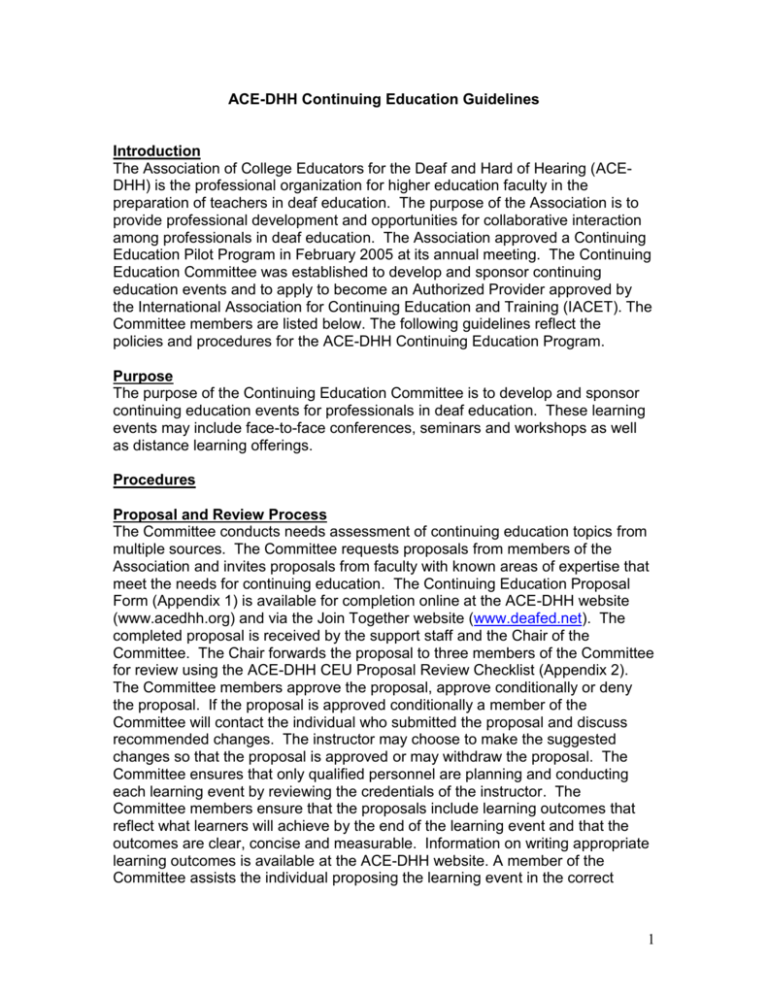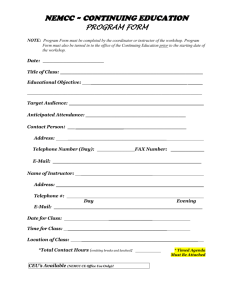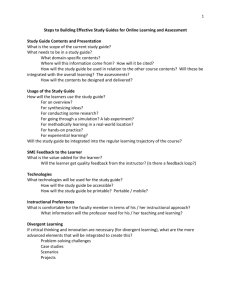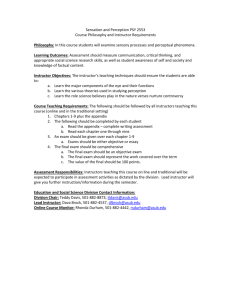ACE-DHH Continuing Education Guidelines
advertisement

ACE-DHH Continuing Education Guidelines Introduction The Association of College Educators for the Deaf and Hard of Hearing (ACEDHH) is the professional organization for higher education faculty in the preparation of teachers in deaf education. The purpose of the Association is to provide professional development and opportunities for collaborative interaction among professionals in deaf education. The Association approved a Continuing Education Pilot Program in February 2005 at its annual meeting. The Continuing Education Committee was established to develop and sponsor continuing education events and to apply to become an Authorized Provider approved by the International Association for Continuing Education and Training (IACET). The Committee members are listed below. The following guidelines reflect the policies and procedures for the ACE-DHH Continuing Education Program. Purpose The purpose of the Continuing Education Committee is to develop and sponsor continuing education events for professionals in deaf education. These learning events may include face-to-face conferences, seminars and workshops as well as distance learning offerings. Procedures Proposal and Review Process The Committee conducts needs assessment of continuing education topics from multiple sources. The Committee requests proposals from members of the Association and invites proposals from faculty with known areas of expertise that meet the needs for continuing education. The Continuing Education Proposal Form (Appendix 1) is available for completion online at the ACE-DHH website (www.acedhh.org) and via the Join Together website (www.deafed.net). The completed proposal is received by the support staff and the Chair of the Committee. The Chair forwards the proposal to three members of the Committee for review using the ACE-DHH CEU Proposal Review Checklist (Appendix 2). The Committee members approve the proposal, approve conditionally or deny the proposal. If the proposal is approved conditionally a member of the Committee will contact the individual who submitted the proposal and discuss recommended changes. The instructor may choose to make the suggested changes so that the proposal is approved or may withdraw the proposal. The Committee ensures that only qualified personnel are planning and conducting each learning event by reviewing the credentials of the instructor. The Committee members ensure that the proposals include learning outcomes that reflect what learners will achieve by the end of the learning event and that the outcomes are clear, concise and measurable. Information on writing appropriate learning outcomes is available at the ACE-DHH website. A member of the Committee assists the individual proposing the learning event in the correct 1 manner for calculating CEU’s and confirms that the calculation is correct according to IACET guidelines. The instructor for the continuing education event is compensated according to the guidelines in Appendix 3. Instructor Responsibilities The Committee ensures that instructors fulfill the following responsibilities: 1. Plan learning events that have appropriate learning outcomes, instructional strategies and assessment. 2. Provide appropriate physical environments for face-to-face learning events. 3. Provide assistance and support to learners. (The support staff may provide additional support and assistance particularly for distance learning events.) 4. Ensure that learning events are accessible. Captioning or voice for signing is required for any video materials. 5. Provide documentation to the support staff on successful completion of learning event for each learner. 6. Adhere to the proprietary interest policy (Appendix 4) and intellectual property rights policy (Appendix 5). Evaluation of Continuing Education Participants in continuing education events are required to complete an evaluation form. The evaluation form addresses learning outcomes, instructional methods, instructor quality and value of content. (Appendix 6) Retention and Releasing of Records ACE-DHH maintains the permanent record of CEUs earned for each learner who successfully completes a learning event. When participants enroll in a learning event, the support staff creates an Excel document that includes the registration information. When the instructor notifies the support staff that learners have successfully completed a learning event the information is recorded in an Excel document and an evaluation form is sent to each learner. If the learning event is a face-to-face event the instructor submits the Excel document with the required information to the support staff. The evaluation form may be completed at the end of the face-to-face session and then sent to the support staff. The support staff provides a copy of the permanent record to the Chair and to the secretary of ACE-DHH after each learning event. The support staff also updates the permanent record on a back-up CD-ROM for safekeeping. The permanent records are kept for 7 years and are available to be issued upon request by the learner. These records will be available via email with password protection. The learners’ records are kept private and secure by the Chair of the Committee, the Secretary of ACE-DHH and by the support staff who maintain the registration and completion of continuing education events. 2 Review of Guidelines The Chair of the Committee reviews these guidelines periodically and brings suggestions for policy or procedure changes to the Committee for discussion and approval as needed. (See Internal Review Guidelines in Appendix 7.) Continuing Education Committee Members Nancy Benham, Chair, Indiana University of Pennsylvania Susan Lenihan, Fontbonne University Marilyn Sass-Lehrer, Gallaudet University Karen Dilka, Eastern Kentucky University Harold Johnson, Kent State University John Luckner, University of Northern Colorado Harry Lang, National Technical Institute for the Deaf nbenham@iup.edu 1/04/06 3 Appendix 1 Continuing Education Proposal Form ACE-D/HH Continuing Education (CE) Proposal Before completing this form, please review the ACE-D/HH Continuing Education Guidelines. If after reviewing the Guidelines you have any questions, contact Dr. Nancy Benham at nbenham@iup.edu. Submission of this CE proposal indicates you have reviewed and agree to the Guidelines' principles. To submit your proposal, complete the items below and click on the "Send" button located at the bottom of this form. Contact Person (person who can answer questions, provide clarifications, etc.) Phone Address (for mailing of CE information/correspondence) Contact e-mail The text of this proposal will be sent to the above e-mail address; for a copy of proposal form, print this out before clicking "send". Alternate e-mail address (not required) ACE-D/HH Member? Yes No (if no, you still may submit a proposal) Name of organization/individual proposing CE activity: 4 Number of attendees expected at the activity: CEU credit proposed (e.g., may be face to face, on-line, & include project work time): 1 CEU Credit - 10 clock hours 2 CEU Credits - 20 clock hours 3 CEU Credits - 30 clock hours Other (detail) Location of activity: on-site on-line 1. Beginning date of activity, workshop & follow-up activities: (MM/DD/YY) 2. End date of activity, workshop & follow-up activities: (MM/DD/YY) 3. Title of activity (not to exceed 12 words) 4. Description of activity (not to exceed 50 words) 5. Instructional level of learner (level of prior knowledge learner needs to successfully participate in this workshop): Introductory Intermediate Advanced 6. Needs Assessment - How was the need for this program established? 5 7. Instructor(s) - for each instructor provide: name, affiliation, and brief description of qualifications. 8. Learning Outcomes - describe the skills, knowledge, and/or attitudes (learning outcomes) participants will be able to demonstrate as a result of the proposed activity. Please write them as clear, concise, and measurable objectives e.g., students will be able to demonstrate, describe, identify, etc. 9. Course Content 10. Instructional Methods 11. Assessment of Learning - How will the instructor assess the learning outcomes, i.e., rubric, work samples, etc.? ** 6 ** For participants to receive CEUs, instructor(s) must provide verification of participants' attainment of learning outcome and participants must complete the on-line evaluation of the learning event. If learning event is face-to-face, a record of attendance sheet must be submitted. See Guidelines for more details. 12. Indicate the method you will use to disclose to participants the proprietary interests or affiliations of each instructor. Announcement by instructor Announcement by person introducing Printed information distributed to participants prior to activity Other (explain) Reminder: if you have questions not answered in the CE Guidelines, contact Dr. Nancy Benham at nbenham@iup.edu. Submission of this CE proposal indicates you have reviewed and agree to the Guidelines' principles. Send Cancel 7 Appendix 2 ACE-DHH CEU Proposal Review Checklist Proposal Title: Instructor: Instructions: This checklist is completed by the Chair of the Committee. If an item is considered unsatisfactory the instructor may consult with a Committee member to revise the proposal so that it is satisfactory. Satisfactory Criterion 1. Well-defined requirements for satisfactory completion are established. 2. When learner attendance is part of the requirements for awarding CEU, the instructor has an appropriate system in place to track and monitor learner attendance. 3. The calculation for the number of CEUs is appropriate. 4. The instructor has agreed to the instructor responsibilities outlined in the ACE-DHH CEU Guidelines. 5. The continuing education event meets needs that have been identified by the Committee from multiple sources. 6. The instructor defines the potential participants/target audience and any prerequisites for the continuing education event. 7. The learning outcomes are clear, concise and measurable written statements (e.g., behavioral or performance objectives) based on identified needs for each continuing education. 8. The instructor is qualified by virtue of education and/or experience. 9. The instructor has ensured that the learning event is accessible. 10. The instructor discloses, in advance of the activity, any proprietary interest in any product, instrument, device, service, or material discussed during the activity. 11. Content and instructional methods are appropriate for the learning outcomes of each activity. 12. Learner interaction and assessments are utilized throughout the programs to reinforce learning, monitor learner progress, and to provide feedback to learners on their programs. 13. Learning assessment methods measure achievement of learning outcomes. Proposal approved: Date: Proposal requires revision related to items: Proposal approved following revisions: Date: Chairperson Signature: 8 Appendix 3 Compensation Chart For events that are sponsored by ACE-DHH in either a face-to-face format or a distance learning format the following chart delineates the fees for the instructor. Compensation will be adjusted for CEUs that are not whole numbers (e.g. an instructor that teaches a .5 CEU learning event to 15 participants would be compensated $175.00). If there are multiple instructors for a learning event, the compensation would be divided as determined by the instructors. In special circumstances, the fees may be adjusted as needed at the discretion of the Committee and the Executive Board of ACE-DHH. 1 CEU # of Participants 15-29 30-59 60+ Instructor Compensation $350.00 $700.00 $1400.00 2 CEUs # of Participants 15-29 30-59 60+ Instructor Compensation $700.00 $1400.00 $2800.00 3 CEUs #of Participants 15-29 30-59 60+ Instructor Compensation $1000.00 $2000.00 $3000.00 An organization that is requesting ACE-DHH CEUs may arrange fees for instructors/presenters in a different manner. The organization will pay $10.00 per participant, with a minimum of 15 participants, to have ACE-DHH review and approve the proposal and to document and maintain the permanent record of the CEUs for the participants. 9 Appendix 4 Proprietary Interest Policy Existing proprietary interests of instructors will be disclosed in the proposal. The ACE-DHH Committee for Continuing Education will require instructors to disclose any proprietary interests prior to learning event through an announcement or printed information distributed to participants. Examples of appropriate disclosures are the following: “The instructor holds patent rights to this instrument.” “The instructor has a financial interest in this instrument.” “The instructor is a consultant to the (name of company).” ACE-DHH does not promote the exclusive use of any commercial product. 10 Appendix 5 Intellectual Property Rights Policy The continuing education courses designed by the instructors belong to the instructors and not to ACE-DHH. If an instructor uses copyrighted materials in the learning event, it is the instructor’s responsibility to follow all rules regarding such use. 11 Appendix 6 ACE-D/HH Continuing Education (CE) Evaluation Form Thank you for sharing your thoughts on a recent CE event/activity. To submit your evaluation, complete the items below. Clicking the "Send" button located at the bottom of this form transmits your evaluation to appropriate ACE-D/HH leadership. Your name* Your e-mail* The text of this evaluation will be sent to the above e-mail address. * This information is required in order to issue CE credit; all identifying information will be removed from this evaluation before it is shared with the instructor. Title of event/activity which you are evaluating: Date(s) of event/activity: Actual event title will be here Actual event dates will be here 1. Learning outcomes identified for this event are listed below; please rate for each how well this event met your expectations. a. First identified learning outcome will be here e.g., can identify types of assistive and listening devices used in deaf education. Exceeded expectations expectations 5 4 3 2 1 Did not meet b. Second identified learning outcome will be here, e.g., can identify beneficial acoustic modifications in a learning environment. Exceeded expectations expectations c. 5 4 3 2 1 Did not meet 2 1 Did not meet Third identified learning outcome will be here. Exceeded expectations expectations 5 4 3 12 d. Fourth identified learning outcome will be here. Exceeded expectations expectations e. 5 4 3 2 1 Did not meet 2 1 Did not meet Fifth identified learning outcome will be here. Exceeded expectations expectations 5 4 3 2. Will you be able to use the knowledge, skills and attitudes you learned at this event in your work? 2a. If yes, how? Yes No If no, please explain why not. 3. Will you share what you learned with other professionals, parent or students? Yes 3a. No If yes, how and with whom? If no, please explain why not. 4. Please rate the CE event on the following criteria: a. If face-to-face event, facilities in which this event was presented (consider location, room space, temperature, lighting). Excellent applicable 5 4 3 2 1 Inadequate Not If you rated the facilities a 1 or 2, please provide details. 13 b. Quality of instruction. Excellent 5 4 3 2 1 Poor If you rated the instruction quality a 1 or 2, please provide details. c. Organization of content. Excellent 5 4 3 2 1 Poor If you rated the content organization a 1 or 2, please provide details. d. If face-to-face, integration of technology appropriate for learning event (consider how well it helped you learn or if it got in the way of learning). Excellent 5 technology used 4 3 2 1 Inadequate No If you rated the technology integration a 1 or 2, please provide details. e. If on-line, application of technology appropriate for learning event (consider how well it helped you learn or if it got in the way of learning). Excellent applicable 5 4 3 2 1 Inadequate Not If you rated the technology application a 1 or 2, please provide details. 14 5. Additional comments 6. Please list any recommendations you have for future Continuing Education (CE) events that would be beneficial to you in your work. Send Cancel 15 Appendix 7 ACE-DHH Internal Review Checklist for IACET Guidelines Instructions: The checklist will be completed annually by the Chair of the Committee and reported to the Committee and Executive Board. Check the most appropriate score for each statement. (S) Satisfactory (W) Weakness (U) Unsatisfactory S W U Criterion 1. Organization: The provider must have an identifiable continuing education or training unit or group with assigned responsibility for administering continuing education and/or training programs. 1.1: The unit or group with responsibility for continuing education or training is clearly identified within the organization. 1.2: A mission statement, goals or other documentation reflect the authority and responsibility for administering CE/T to the provider unit/group. 1.3: The provider unit/group administers CE/T activities, courses, or programs as evidenced by a description of such programs. 2. Responsibility and Control: The provider, through its continuing education or training unit, ensures certification criteria are followed. 2.1: Internal policies clearly indicate a review process that adheres to the criteria. 2.2: The review process is conducted by individual(s) who have been trained and/or have experience in the criteria 2.3: Authority and responsibility for adherence to the criteria are clearly vested in the appropriate individuals responsible for the review process 2.4: The review process incorporates the latest revisions in the criteria. 3. System for Awarding the Continuing Education Unit: The provider has a system in place to identify learners who meet requirements for satisfactory completion and maintains a complete permanent (at least seven years) record of each learner’s participation. 3.1: Well-defined requirements for satisfactory completion are established for each planned learning event. 3.2: Learners are informed of the satisfactory completion requirements prior to the learning event. 3.3: Learners are notified if they have not met satisfactory completion requirements (e.g. IACET CEU will not be awarded.) 3.4: A systematic process is used for identifying individuals who satisfactorily complete a course or program. 3.4a: When learner attendance is part of the requirements for awarding CEU, the provider has an appropriate system in place to track and monitor learner attendance. 3.4b: When partial credit is awarded to learners who do not attend the entire activity, there is a system to track, calculate, and award variable credit. 3.5: A process is in place for calculating the number of IACET CEUs available for each learning event. 3.6: A permanent record system for learner records is operational. 3.7: Permanent records contain information referenced in the guidelines. 16 3.8: The permanent record information is presented in a manner, which a third party can readily interpret (i.e., no codes or codes explained). 3.9: Records are kept up-to-date. 3.10: A system is in place to issue an up-to-date copy of a permanent record to a learner or others authorized within six weeks or less. 3.11: A written policy is operational to ensure the privacy and security of learners’ records. 3.12: A written policy is operational on retention and releasing of records. 4. Learning Environment and Support Systems: A learning environment and support services appropriate to the continuing education or training goals and learning outcomes is provided. 4.1: The organization has a process for determining the resources, to include financial resources and administrative support, required to support the learning outcomes and ensuring that the resources will be sufficient/available to maintain programs/courses through to completion. 4.2: The physical environment (i.e., light, sound, seating, etc.) is appropriate for the learning activities. 4.3: Access to the facilities equipment, learning experiences and resource materials is provided. 4.4: Educational services and technical support are provided to instructors and learners. 4.5: Instructors and/or advisors are available to provide assistance and support to learners. 5. Needs Identification: Each program or activity is planned in response to identified needs of a target audience. 5.1: An established process provides objective needs assessment data, which is the basis for program planning and development. 5.2: Potential learners and/or multiple sources of information are tapped for needs assessment. 5.3: Needs assessments are documented, reviewed and updated. 5.4: Activity, course or program topics and content must originate from identified needs. 5.5: The provider defines the potential participants/target audience and any prerequisites for each learning event and includes this information in catalogs and promotional efforts. 6. Learning Outcomes: The provider has clear and concise written statements of intended learning outcomes (e.g., behavioral or performance objectives) based on identified needs for each continuing education and training program. 6.1: Planned outcomes are based on identified needs. 6.2: Written learning outcomes that reflect what learners will achieve are established for each course or program. When learning outcomes are established for a program, each course within that program must be keyed to one or more of the program outcomes. 6.3: Learning outcomes are established for large activities such as conferences or conventions. Each session within that activity has its own learning outcomes or is keyed to one or more of the overall activity outcomes. 6.4: The number of planned outcomes is appropriate for the learning activity. 6.5: Outcome statements are clear, concise, and measurable. 6.6 Learners are informed of intended learning outcomes. 17 7. Program Planning and Instructional Personnel: Qualified personnel are involved in planning and conducting each activity. 7.1: Individuals involved in program planning and instruction are qualified by virtue of their education and/or experience. 7.2: Expertise in course content and instructional methodologies is used in developing learning activities. 7.3: Individuals involved in event planning understand and utilize learning outcomes in program planning and development. 7.4: Instructors are reasonably and consistently effective in meeting learning outcomes and learner expectations. 7.5: Instructors are provided feedback on their performance. 7.6: Instructors demonstrate high standards of professional conduct and do not discriminate against learners on the basis of gender, age, socioeconomic or ethnic background, sexual orientation, or disability. 7.7: The provider discloses, in advance of the activity, any instructor’s proprietary interest in any product, instrument, device, service, or material discussed during the activity and the source of any compensation related to the presentation. 8. Content and Instructional Methods: Content and instructional methods are appropriate for the learning outcomes of each activity. 8.1: Subject matter and content are directly related to learning outcomes. 8.2: Instructional methods are consistent with learning outcomes. 8.3: Instructional methods accommodate various learning styles. 8.4: Content is organized in a logical manner. 8.5: Learner interaction and assessments are utilized throughout the programs to reinforce learning, monitor learner progress, and to provide feedback to learners on their programs. 8.6: The provider has established policies and procedures to address intellectual property rights. 9. Assessment of Learning Outcomes: Procedures established during program planning are used to assess achievement of the program’s learning outcomes. 9.1: Learning assessment procedures are established during program planning. 9.2: Learning assessment methods measure achievement of learning outcomes. 9.3: Learners are informed in advance that learning outcomes will be formally assessed. 10. Post-Program Evaluation: Each learning activity is evaluated. 10.1: Post-program evaluation procedures for each learning activity are established during event planning. 10.2: Evaluation methods are comprehensive. 10.3: Summative evaluations are prepared and analyzed based on the following minimum components: 10.3a: Did the learning experience and the instructional methods used result in individual behavioral or performance change (i.e., the learning outcomes)? 10.3b: Did the learners indicate that the learning outcomes were appropriate for the stated course/program purpose and for the learners involved? 10.3c: Was program execution effective and efficient? 10.4: Evaluation results are incorporated into program improvements. 18







